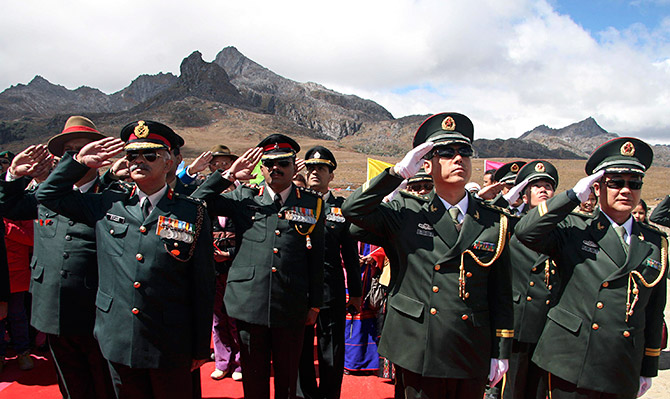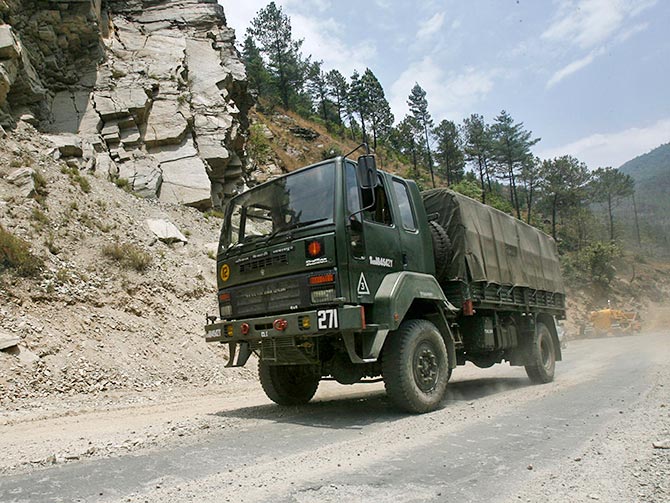India's military power at LAC rattles China
Rediff News
http://www.rediff.com/news/special/indias-military-power-at-lac-rattles-china/20170726.htm
July 26, 2017 14:12 IST
'India's military posture has become significantly stronger than China's on the 3,500-kilometre Line of Actual Control.'
'This is enhancing confrontation between the two sides,' points out Ajai Shukla.
'This is enhancing confrontation between the two sides,' points out Ajai Shukla.

IMAGE: Indian and Chinese soldiers attend the celebrations to mark the 60th anniversary of the founding of the People's Republic of China at the India-China border, about 41 km from Tawang district in Arunachal Pradesh, October 1, 2009. Photograph: Utpal Baruah/Reuters
What motives underlie the month-long standoff between Indian Army troops and Chinese border guards in the Doklam bowl, on the Sino-Indian border in Sikkim?
What is at stake there for India and China?
How could this play out, and is there a real threat of war?
The confrontation began in mid-June, when the Chinese entered the Doklam bowl, a picturesque, 89 square kilometre series of meadows near the Nathu La border crossing between Sikkim and Tibet's Chumbi Valley.
Doklam is claimed by both China and Bhutan; while China, India and Bhutan do not agree where their borders meet.
The Chinese and Bhutanese armies send occasional patrols to Doklam in summer, while graziers from both sides herd their yaks here -- traditional ways of staking claim to Himalayan territory -- but the patrols and graziers are only temporary visitors.
Last month, however, Chinese road construction crews, escorted by border guards, disturbed this delicate status quo by attempting to consolidate permanent “facts on the ground.
Barging into Doklam, they began extending a mud-surface road they had partly built more than a decade ago.
This rough track would connect Doklam to Highway S-204, a blacktop Chinese road in the Chumbi Valley, theoretically allowing Chinese troops to drive directly from the Tibetan city of Shigatse, through Yadong, across the border into Doklam, and then south to China's claimed border line at Gyemochen (which the Chinese call Mount Gipmochi).
A Chinese road in this disputed territory would add weight to Beijing's claim over it.
Since India does not claim the Doklam bowl, China's entry placed the ball squarely in Bhutan's court.
Thimphu had not objected forcefully when China had encroached into the Doklam bowl in 2003-2007, and it was -- understandably, given Bhutan's power differential with China -- reluctant to intervene now.
Consequently, Indian troops in the vicinity, acting in accordance with New Delhi's foreign policy coordination treaty with Thimphu, crossed on June 16 into Bhutanese-claimed territory and physically blocked the movement of Chinese border guards.
India also positioned two bulldozers in the Doklam bowl to undo any road construction by the Chinese.
Since then, several hundred Indian soldiers and as many Chinese border guards (since their army does not guard the border) have come face to face in Doklam in a testy stalemate.
Backing up their soldiers on the ground, foreign ministry spokespersons in Beijing, Thimphu and New Delhi have rationalised their positions.
On June 26, Beijing invoked an 1890 agreement between China and Great Britain that specified Mount Gipmochi as the border junction.
Three days later, Thimphu cited agreements in 1988 and 1989 not to disturb the status quo.
The next day, New Delhi pointed out that Beijing had agreed in 2012 to finalise the border tri-junction consultatively and that 'unilaterally determin[ing] tri-junction points is in violation of this understanding.'
Threat to the Siliguri corridor?
Indian commentators have claimed that New Delhi's unusual resoluteness in this confrontation stems from a threat to the Siliguri corridor -- a 23 kilometre-wide funnel of Indian territory that squeezes between Nepal and Bangladesh, giving India access to its seven north eastern states.
Siliguri is just 80 kilometres from the current border. It is argued that allowing China to shift the border to Mount Gipmochi would bring the threat even closer.
In fact, this danger is dramatically overblown.
A Chinese advance to Siliguri would require the mobilisation of large numbers of People's Liberation Army (PLA) troops from around Lhasa, and Mainland China.
Dennis Blasko, a leading expert on the Chinese military, says the PLA's ongoing reorganisation aims to increase the 'new-type combat forces', which are capable of being used anywhere in China or its borders, but there are not enough of these forces in Tibet to break through India's forward defences in Sikkim.
Bringing in sufficient numbers and acclimatising them to Tibet's high altitudes would take the PLA weeks, losing strategic surprise and allowing India to comfortably reinforce its defences in Sikkim.

IMAGE: An Indian Army truck drives along the Tezpur-Tawang highway, which runs to the Chinese border, in Arunachal Pradesh. Photograph: Frank Jack Daniel/Reuters
If moving appropriate troops into the Chumbi Valley is a logistical challenge, shielding them from Indian artillery, air and ground attacks in that bottleneck would be even more difficult.
Thereafter, the PLA would have to break through formidable Indian defences, attacking mainly uphill, and then advance southward to Siliguri across thickly forested hills, harried all the way by numerically superior Indian forces.
Such an advance, carried out cross-country, would inevitably leave behind artillery and logistic support, rendering Chinese infantry spearheads sitting ducks for Indian forces.
If, miraculously, the Chinese still reach Siliguri, they would be decimated in massed attacks from Indian reserves that could be built up steadily.
"Sikkim is where India attacks China, not the other way around," say typically blunt planners in New Delhi.
Lieutenant General S L Narasimhan (retired), who has commanded a brigade and a division in Sikkim and now serves on India's National Security Advisory Board, has written that concerns about Siliguri are overblown.
The Bhutan factor
With Siliguri not a major concern, New Delhi's purposefulness at Doklam stems, more likely, from the belief that Beijing is testing India's commitment to Bhutan.
China has always been galled by this close relationship which has withstood sustained Chinese pressure to divide it.
At Doklam, military pressure and Beijing's unprecedented rhetoric have been reinforced by diatribes from Chinese and China-friendly media, alleging India's colonial exploitation of Bhutan.
Neville Maxwell, as always in lockstep with Chinese propaganda, writes in the South China Morning Post: 'The Indian attempt to depict this confrontation as tripartite should be disregarded. Bhutan is not an independent actor (but) rather an Indian glove-puppet.'
Maxwell makes the outrageous assertion that New Delhi keeps Thimphu in line by permanently stationing an army brigade group (3,500 to 5,000 troops) in Bhutan.
Numerous Indian and international commentators too have incorrectly cited similar numbers.
In fact, India's military presence in Bhutan is restricted to 800 trainers for the Royal Bhutan Army, and about 100 soldiers with the Border Roads Organisation, which builds and maintains several Bhutanese roads, using civilian hired labour.
New Delhi understands that backing off would amount to throwing Bhutan under the Chinese bus, allowing Beijing to dictate a border settlement with Thimphu.
On the other hand, Beijing understands that allowing India to intervene militarily on behalf of Bhutan would send an undesirable message to other regional States that China seeks to keep divided and mindful of its status as the next global superpower.
New Delhi remains firm about its support to Bhutan.
Says former national security advisor, Shivshankar Menon, in a media interview: 'We have a certain relationship and certain obligations to Bhutan. In this case, China's actions have disturbed the status quo, and that needs to be addressed.'
How much of a flashpoint?
The Doklam confrontation does not yet appear a flashpoint that could trigger open hostilities.
No shots have been exchanged in contrast to the 1967 gun battles at Nathu La and Cho La, just kilometres from Doklam, in which 88 Indian soldiers were killed and 163 wounded; and an estimated 340 Chinese soldiers died and 450 were wounded.
Nor is this the longest or most tense faceoff ever.
That dubious distinction goes to the 1986-1987 crisis on the Sumdorong Chu (rivulet) near Tawang, after China occupied the disputed Wangdung grazing ground and the Indian Army responded with a months-long build-up of tens of thousands of troops along the McMahon Line.
Beijing quickly understood that New Delhi had abandoned its post-1962 defensive mindset and the crisis was resolved, leading on to the Peace and Tranquillity Agreement of 1993 and the Confidence Building Measures of 1996 that have kept the peace on the border ever since.
But this equilibrium has now been disturbed, and both sides have played roles in it.
American Sinologist John Garver, writing in the South China Morning Post, says a rising and assertive China, looking to be the paramount power in Asia, wants to serve up a public lesson to India -- which it sees as the weakest link in a chain of States, including the US, Japan and Australia, that are trying to contain China.
Supporting this rationale for Beijing's shrill aggression over Doklam, other commentators have pointed to China's opposition to India's membership of the Nuclear Suppliers Group, its blocking of a UN resolution to declare Pakistan-based Masood Azhar a global terrorist, New Delhi's unapologetic backing of the Dalai Lama, including a government-sponsored visit to Tawang, and the Indian government's forthright rejection of China's flagship Belt and Road Initiative.

IMAGE: A ceremonial reception for China's President Xi Jinping at Rashtrapati Bhavan, September 18, 2014. Photograph: Ahmad Masood/Reuters
In the Indian Ocean too New Delhi is lining up more visibly against China, with its navy cooperating and training regularly with the American and Japanese navies in exercises like the recently concluded Exercise Malabar.
While deteriorating Sino-Indian relations are a reality, there is insufficient recognition of the fact that border incidents are increasingly triggered by India's increasing military strength and an increasingly assertive posture on the border.
Over the last decade, India has strengthened its defences in Arunachal Pradesh by adding two divisions (35,000 to 40,000 troops), and is raising a mountain strike corps (60,000 troops) that can operate in Ladakh, Sikkim or Arunachal Pradesh.
Besides these, India has moved more than two brigades (7,000 to 10,000 troops) from Kashmir to Ladakh and strengthened defences further with the induction of tank and armoured infantry units.
The little-known upshot is that India's military posture has become significantly stronger than China's on the 3,500-kilometre Line of Actual Control.
This is enhancing confrontation between the two sides.
For decades, India maintained an insignificant military presence in Daulet Beg Oldi, in Ladakh, ceding the run of the place to China.
But when India's thickening troop presence blocked Chinese patrols into the area, a prolonged confrontation ensued in 2013.
One general involved in that standoff says: "The Chinese demanded to know why we were blocking them now, when they had been patrolling that area for years."
A similar confrontation took place in Chumar, in Ladakh, in 2014.
Now, in Doklam, Chinese anger stems from being blocked in 2017, after facing no resistance between 2003 and 2007, when they tested the waters by building the existing track.
Furthermore, a more active media in both countries is bringing confrontations to public attention, forcing both governments into harder-line stances and depicting as surrender the give-and-take that must necessarily accompany the resolution of each incident.
No comments:
Post a Comment